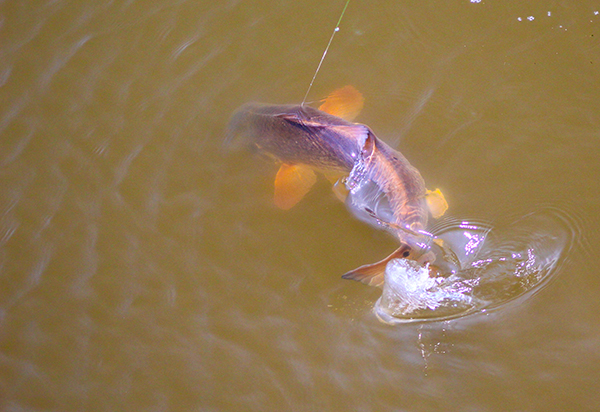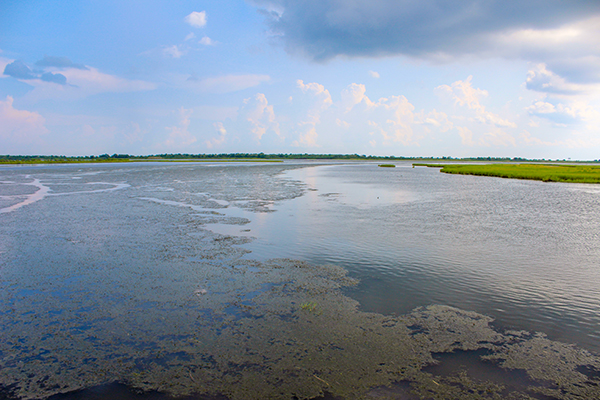Don't let the extreme heat melt your chances of success. Fishing is still as good as ever, just use these simple strategies.
One of the greatest experiences of being an inshore angler is watching the seasons come and go. We have an appreciation for contrasting weather that cannot be found amongst those hiding indoors.
We love the light winds of summer, for it is easy to cast and we cherish the harsh northwest winds of a cold front, as we know the good fishing coming on its heels.
The seasonal changes in the prairie marsh are like a pendulum, swinging back and forth. To appreciate winter, you must sweat through summer. To welcome summer you must freeze through winter.
And summer is here. Louisiana is experiencing the hottest days of the year, colloquially known amongst natives as the "dog days of summer." We are nearing the end of the pendulum's swing and it won't be long before the winds shift, the fish move and the landscapes change.
These sweltering conditions present obstacles to good fishing. Here is how you should be catching specks and reds during the dog days of summer:
Catching Specks and Reds during the Dog Days of Summer
When you step outside in the Louisiana summer you immediately notice the sweltering heat and humidity. It is indisputably hot.
Believe it or not, it is just as hot for the fish. When fish get hot, much like you, they become lethargic and don't want to move around much.
"Dog Days" Strategy for Speckled Trout
Speckled trout are efficient predators and creatures of habit. They are going to get what they need to eat then bide their time resting. They are not going to work any harder than what they have to, much like me or you.
Considering this, it shouldn't be surprising to learn that speckled trout are going to feed first thing in the morning when it is still cool outside.
The key to success with speckled trout is to fish for them early. The earlier the better. It's not uncommon to hear of guides getting to their first fishing spot for 4am and having their limit for a little after 6am.
This is an extreme example, but it illustrates the idea of fishing early very well. Generally, when I am fishing the summer pattern I am leaving the dock for no later than 5am.
Bigger trout tend to bite earlier in the morning and, as time progresses, the bigger trout gave way to smaller trout.
Smaller speckled trout do this because they must eat as much as they can in order to become larger.
The bigger they are, the fewer things can eat them. As they grow they become more experienced and feed in narrower windows.
Given all of this information, the "hours of power" for a good speck bite runs from before sunrise to about 9-11 AM.
The trout bite is generally over once noon hits and the water becomes hot.
There have been times I was able to bail out fishing trips by focusing on smaller trout and working through the throwbacks. I knew they would feed longer than the "bigger" speckled trout.
Note So everyone is on the same sheet of music, this article is focusing on "school" trout.
When I say "big" I am referring to four pound and up speckled trout. When I say "small" I mean speckled trout that are ten to twelve inches long.
Additional tips for "Dog Days" Speckled Trout
Trout hate being hot and exposed to sunlight. Would you want to hang out in an asphalt parking lot at high noon? Neither do trout. They want to be in the shade, just like you.
Across Louisiana's coastal waters there are numerous natural gas platforms that provide shade for speckled trout to hide in.
Sometimes they will hide inside this shade, even directly under the platform and between the legs. I like to toss my line under the platform and let it sink down to the bottom.
Be Advised
This is an advanced tactic. You risk snagging your line or, worse yet, bumping your boat into the rig.
Shade is also found in deep water, another reason why trout like deep holes.
Exception
I have found overcast and stormy weather will keep temps down, allowing speckled trout to bite throughout the day.
"Dog Days" Strategy for Redfish
Sexually mature speckled trout have vacated the nearby marsh and are feeding in far off bays and sounds, but redfish are caught much closer to the dock.
Additionally, the "hours of power" for redfish last much longer. Redfish are tougher and more resilient than trout. If there is enough cloud cover, redfish will keep patrolling and eating all day long.
Finding redfish spots is easy, and I cover that in How to Find Awesome Redfish Spots. What's key here is to keep the summer heat in mind.

We all know redfish are typically found along the shoreline, or some kind of cover, patrolling for bait to eat.
If the pond has aquatic grass you can expect them to come off the shoreline and patrol the grass. However, with the addition of summer heat, you can will see redfish take cover in the middle of the pond, where the water is deepest, in an effort to cool off. The deeper water in the middle of the pond can be a degree or two cooler.
A couple degrees isn't a big difference for me or you, but for a redfish it is everything.
Don't be surprised to see redfish hiding inside mats of aquatic grass. It's a great place for them to find shade and fresh, oxygenated water.

Thick grass mats like these pose challenges for anglers. Only those who Fish Smarter successfully pull fish from them.
Additional tips for "dog days" Redfish
Not all ponds will hold redfish.
Some are too shallow and become too hot for them to inhabit. If you pull into a pond that is packed with gar and mullet, then chances are there are only gar and mullet in there.
Those fish are capable of breathing air to supplement their oxygen needs. Redfish can't.
Besides, if a pond is so thick with trash fish then why would you want to fish it? When you inevitably spook the mass of mullet or a huge gar they will, in turn, spook the redfish.
Pay attention to the water.
The water is everything. Generally, moving water will be cooler than slack water. This is why I still look to fish tidelines that hold specks and reds. However, you must pay attention. This is how you will succeed in catching specks and reds during the dog days of summer!
Knowledge Bomb:
Don't waste much time fishing a shoreline if a falling tide is dragging hot, de-oxygenated water from a nearby pond across it.
I start to see fish shut down when the water temperature reaches the high 80s and low 90s.
Most boaters get the water temp from their transducer, but keep in mind where your transducer is mounted. If it is only an inch or two below the surface then chances are it is getting a biased reading from the sun shining directly on it.
Conclusion
That's it for catching specks and reds during the dog days of summer! If you have any advice to share then be sure to chime in below in the comments.
Tight lines, y'all!

Thanks for reading!
Al, that’s absolutely correct!
Good timing on this “old” information!
Always enjoy your knowledge of fishing. After 70 years of fishing I have found one thing out for sure, Everyday is a learning day.
Hey Jason, thanks for commenting.
Honestly, you’re in the right place. There’s tons of information here on the Blog as well as on my YouTube channel: https://www.youtube.com/lafishblog
This video could be good for you: https://www.youtube.com/watch?v=m95OLNO-PgA
NEED ADVICE! I’m heading down from Tyler Texas to Morans (port Fourchon)at the end of the month of August for a couple of days then to Boudreaux motel (Leeville)for a few days with my daughter. I haven’t fished them in years and my daughter just hit 10 yoa so she’s finally old enough to go. I have a 198 Carolina skiff. If weather permitting we will try close rigs out in the gulf, if not it’s bay and marsh fishing for us. Any advice of where to go, what bait etc is welcomed!! I want this to be a fun trip for her like I had as a kid. Thanks in advance! [email protected]